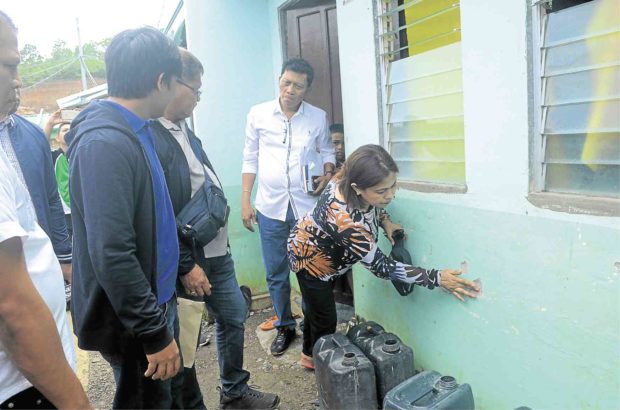Folk displaced by ‘Yolanda’ get substandard houses

LOSS AND REMEMBRANCE Residents visit a mass grave in Tacloban City for the victims of Supertyphoon “Yolanda” on Thursday, five years after the howler killed more than 7,300 people and left a swath of destruction in the Visayas. —AFP
(Second of three parts)
ILOILO CITY—At least 1,000 houses for the survivors of Supertyphoon “Yolanda” (international name: Haiyan) at the coastal village of Bacjawan Sur in Concepcion town, about 101 kilometers north of here, have been found to be substandard.
Separate investigations by the Department of Public Works and Highways (DPWH) and the engineering offices of the province and Concepcion town have the same finding: The houses at Bacjawan People’s Village Site No. 1 don’t meet the required project specification of 3,000 psi (pounds per square inch).
This means the houses, particularly the walls, cannot withstand even a slight earthquake.
“Failure to meet this requirement of 3,000 psi may cause cracks and eventual collapse of the structure in case of an earthquake. Failure to meet this requirement is very hazardous, as it puts at risk the lives of the occupants,” DPWH engineers Victor Diomo Jr., Jeylourd Riofrir and Glory Jean Garin said in their report dated June 19.
Joint venture
The housing project, worth P289.8 million, was awarded to Urban Consolidated Construction Phils. Inc. and HerCar Builders Inc., whose joint venture is also known as UCC-HerCar.
Started on June 20, 2015, the project was supposed to be completed within 405 days under the supervision of the National Housing Authority (NHA).
When reached for comment, NHA officials opted to furnish the Inquirer documents on the project rather than issue a statement.
The defects would not have been discovered if not for Typhoon “Nina” (international name: Nock-ten), which hit Concepcion on Christmas Day in 2016.
The municipal government relocated 45 residents of Sitio Ranchohan at Barangay Bacjawan Sur to the NHA houses even if they were not Yolanda survivors because of the threat of landslide in their sitio.
They, however, complained that the houses had defects.
Since the houses had not been formally turned over by the contractor, the residents were asked to file formal complaints.
More complaints
But the complaints increased when 300 recipients, who were the original Yolanda survivors, occupied the houses in 2017 without waiting for the formal turnover.
“It was at this point when the complaints for defects and poor quality of construction poured in,” said the Aug. 7 joint report of the provincial board committees on justice, good government and human rights, social welfare, housing, senior citizens and persons with disabilities; and infrastructure.
The municipal council investigated and the contractor agreed to “rectify the defects” within a month.
When the contractor failed, the matter was referred to the provincial board, which called a joint committee hearing on June 21.
The NHA engineers assured the board that specifications had been complied with as they were present during the construction and even brought samples of the concrete mixture for laboratory examination as standard operating procedure.
Herminio Carreon, president and chief executive officer of UCC-HerCar, said the houses were constructed in accordance with standards.
He told the board that the poor quality of the finished houses “was due to the poor quality of water used” while the construction of the other houses “was not closely monitored.”

SUBSTANDARD Officials of the Iloilo provincial government and the National Housing Authority check one of the 1,000 housing units built for victims of Supertyphoon “Yolanda” at Barangay Bacjawan Sur, Concepcion town, in this June 8, 2018, file photo. Since moving into the homes in November last year, occupants have been complaining about cracks on the floors and other structural defects. —IAN PAUL CORDERO/PANAY NEWS
Houses weak
But random inspection by DPWH engineers showed the walls of the houses were weak.
The concrete walls and slabs indicated, among other defects, that either the cement quality was poor or the design mix was improper.
The provincial engineer’s office (PEO), in a separate report on June 19, said the reinforced bars on walls were rusty while an unpleasant sound and movement on the walls were noticed when these were pounded.
The PEO report pointed out deteriorated wood studs of interior partitions, poked holes on external walls and floors, poorly installed panel doors and cracks on pavements.
It said the substandard wall was “caused by poor quality of materials that were used during the construction.”
According to the Provincial Board joint committee report, 89 percent of the project cost, or about P257 million, had already been paid to the contractor although the NHA had not accepted the project, which required prior evaluation or assessment by a separate team from the NHA central office and inspection by the Concepcion municipal government.
No mention in COA report
Incidentally, the irregularity in the housing project in Concepcion was not mentioned in the 2017 Commission on Audit (COA) annual report on NHA released in August.
Instead, the COA dealt with eight other projects in Iloilo, which were evaluated based on the constructors’ performance evaluation system (CPES).
As of Jan. 31, three projects had unsatisfactory and poor ratings during the first visits.
Malayuan People’s Village Site 1 in Ajuy town, Iloilo, and Hamod People’s Village in Batad town had high completion of rates of 86 percent and 85 percent.
But both were given unsatisfactory ratings.
The Villa Regeneracion Site 1 had an accomplishment rate of 90 percent but its CPES rating was poor.
Only one project—San Rafael Prosperity Homes Development—was given a satisfactory rating, while four other projects had no rating.
Notice of termination
But the COA said an order and notice of termination was issued to Dumangas People’s Village in Dumangas town and Villa Regeneracion Site 3 after the contractor suffered negative slippage 27.35 percent and 45.05 percent, respectively.
The COA also recommended that Hamod People’s Village should be issued a notice of termination since its negative slippage reached 34.22 percent.